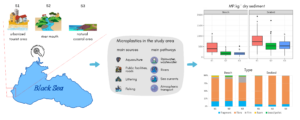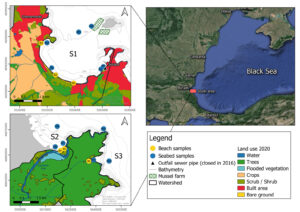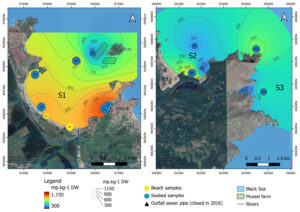A new article by the staff members of the Laboratory of Marine Laboratory in Sozopol (unit of IBER-BAS) Nikola Bobchev (PhD student), Dr Dimitar Berov, Dr Stefania Klein and Assoc. Prof. Dr. Vencislav Karamfilov was published in the internation journal Marine Pollution Bulletin (IF 5.3). It presents data on microplastic pollution in sediments of beaches and the seabed along the southwestern coast of the Black Sea, specifically in the area of Sozopol Bay, the mouth of the Ropotamo River and Maslen Cape. Fig. 1
The results show that the highest concentrations of microplastics were found near urbanized areas (Sozopol Bay – 464.44 ± 272.50 particles per kg of beach sand and 825.93 ± 396.30 particles per kg of seabed sand). Fibers were the most common type, comprising 72.3% of the microplastics on the shore and 91.7% on the seabed. Additionally, 44% of the particles on the shore and 54% of those on the seabed were red or blue.
The concentration of microplastics in the sediments of the beaches “Zlatna Ribka,” “Gradina,” and “Chernomoretz,” located between the towns of Sozopol and Chernomorets, was 2 to 4 times higher than in other parts of the Black Sea. In contrast, concentrations in non-urbanized or sparsely urbanized areas were similar to those found in other studies from the Black Sea and other European seas. The concentration of microplastics in seabed sediments in this area was higher than in other studies from the Black Sea but similar to levels of microplastic pollution in seabed sediments of the Caspian Sea, Baltic Sea, the English Channel and the Belgian continental shelf.
Potential major sources of pollution include microplastics carried from land via wastewater and stormwater runoff as well as degradation of plastic objects that have entered the sea from household waste, tourism, fishing and aquaculture. It has been confirmed that marine sediments act as a “reservoir” for microplastics, which remain archived in them for long periods of time and are indicative of the long-term levels of pollution in coastal ecosystems, especially from urbanized coastal areas and the human activities occurring there.
Link to the article https://www.sciencedirect.com/science/article/pii/S0025326X24011275
Link to Laboratory of Marine Ecology – Sozopol http://www.iber.bas.bg/?q=bg/node/111








